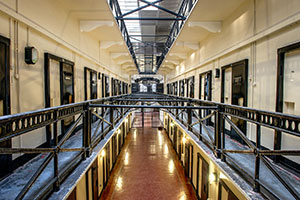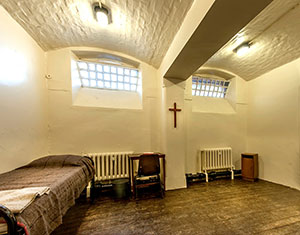Crumlin Road Gaol
Published in Issue 2 (March/April 2017), Reviews, Volume 2553-55 Crumlin Rd, Belfast
www.crumlinroadgaol.com
By Tony Canavan

Above: The main entrance.
For such a grim building with such a grim past, Crumlin Road Gaol presents a merry face to the world. As well as having a café and a restaurant, it is host to grand balls and concerts by the likes of Garth Brooks and Abba tribute bands. It is now one of Belfast’s major tourist attractions.

Above: Crumlin was the first gaol in Ireland to use the ‘silence and separation’ system, whereby there was only one prisoner per cell and, with a rule of silence, prisoners were hooded when outside their cells.
We actually leave the prison to start the tour, as we go down the tunnel connecting the gaol with the now-derelict Crumlin Road courthouse. The tunnel was constructed to enable the safe passage of prisoners and is one of the bleakest parts of the prison. Next we are led into the reception area, where our guide, Harry, cheerfully asks us to empty our pockets into the numbered sacks provided before stepping into one of the cubicles to undress. This kind of black humour characterises his patter throughout and is a welcome relief from the overall grimness, especially on a cold winter’s day. Harry explains that, from 1846 up to its closure in 1996, that’s what all incoming prisoners had to do before being washed, medically examined and issued with a uniform.

Above: The tunnel connecting the gaol with the now-derelict Crumlin Road courthouse.
As we go through the building, seeing the governor’s office, the wings, cells and so on, Harry fills us in on the history of the gaol and the prison system generally. Crumlin was the first gaol in Ireland to use the ‘silence and separation’ system, whereby there was only one prisoner per cell and, with a rule of silence, prisoners were hooded when outside their cells. A more ‘humane’ regime was later introduced when it was seen that this system did nothing to reform inmates. Nevertheless, the regime continued to involve hard labour and corporal punishment of various kinds, the worst of which was being lashed with the cat-o’-nine-tails, a particularly nasty whip. Not just men but also boys were subjected to lashing, although in the latter case with a birch.
Incidental to this, Harry explains how a number of phrases still in everyday use originated in prison. ‘Has the cat got your tongue?’ was a taunt to those who had just been whipped and were in no position to talk. ‘Being carpeted’ usually preceded the cat-o’-nine-tails, as the governor’s office was the only room with a carpet and he decided on the punishment for prisoners who broke the rules. And ‘being for the long drop’ meant being sentenced to be hanged.

Above: To be in the actual cell where a real person had spent his last days does make a chill go down your spine.
The most harrowing part of the visit was being taken through the last hours of a condemned man. It all looked familiar, as we have all seen it in films, but to be in the actual cell where a real person had spent his last days does make a chill go down your spine. This was the only cell that was en suite but even that was a cheat, as the bathroom contained a secret door leading into the execution chamber. This part of the tour is not for the faint-hearted: parents were advised to think twice about taking their children here. The gallows humour was absent as Harry explained just how a man was hanged. It really struck home when you realised that this was the actual gallows, trapdoors and rope that had been used to execute fourteen men (the first three executed at Crumlin Road were hanged in public). Being taken downstairs to where the body fell and was left to die is an experience difficult to put into words. It was a relief to be taken outside, even if it was to the place where the executed were buried in unmarked graves.
Of course, we could not ignore the more recent history in the shape of the Troubles. Loyalists and Republicans were held in the gaol, swelling its numbers beyond what it was designed to accommodate. To this strain was added the campaigns for political status and the infighting between the paramilitary groupings. Crumlin Road held some ‘celebrity’ prisoners, such as Ian Paisley, who would become the First Minister of Northern Ireland, and Gerry Adams, president of Sinn Féin. And it must not be forgotten that prison officers themselves were often casualties in these times.
It has to be said that the commentary about these years was scrupulously neutral. In fact, whenever possible no mention was made of the likes of the IRA or UVF. Notable incidents, like an escape for example, were related without mentioning which organisation was involved. Most people on the tour with me were locals and could read between the lines, but outsiders may have been left in the dark.
Crumlin Road Gaol is not unique in being a tourist attraction nor in having a grim past. The difference is that some of its past is living memory rather than history, and this does add a frisson to the visit. I would recommend the tour to anyone; I would even recommend making the trip to Belfast for it. The prison has been well preserved and there are exhibits throughout, adding another dimension. If Harry is anything to go by, the guides know their stuff and how to convey it with the right mix of seriousness and humour.
Tony Canavan is editor of Books Ireland.
















